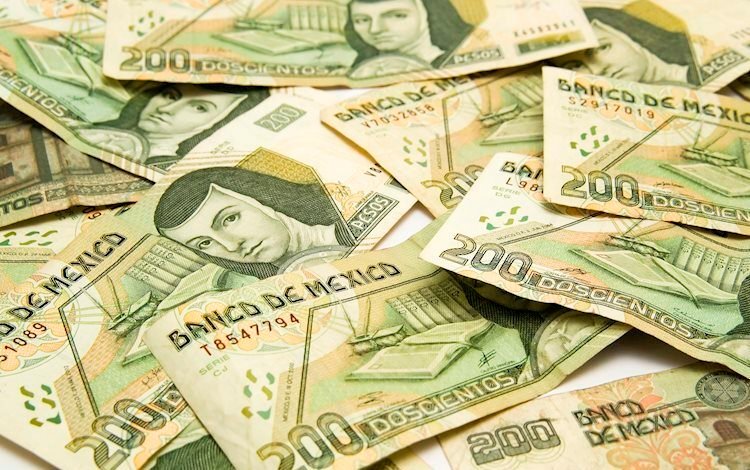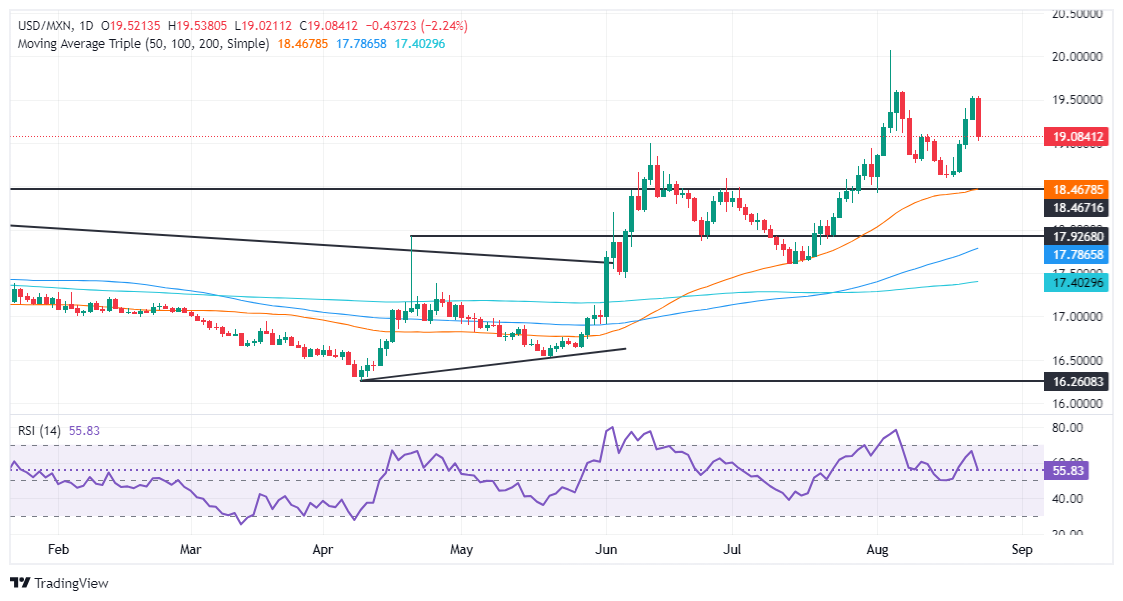Mexican Peso strengthens as Powell pivot weighed on US Dollar

- Mexican Peso rallies sharply with USD/MXN falling over 2%.
- Mexico’s economy shows mixed signals, with Q2 GDP growth at 2.1% YoY but a contraction in economic activity, as Banxico debates the appropriateness of recent rate cuts.
- Powell’s speech at Jackson Hole hints at upcoming rate cuts.
The Mexican Peso rallied sharply against the Greenback on Friday after Federal Reserve (Fed) Chair Jerome Powell announced that the central bank is ready to begin its easing cycle. This undermined the US Dollar, which is tumbling to a new yearly low, according to the US Dollar Index (DXY). Therefore, the USD/MXN collapses over 2% and trades at 19.06 after retreating from a daily peak of 19.53.
The USD/MXN extended its losses on Powell’s remarks, who said, “The time has come for policy to adjust.”
He added that the Fed is data-dependent regarding the size and timing of easing and added that he’s confident that inflation will hit the Fed’s 2% goal. Regarding achieving the maximum employment task, he said that risks are skewed to the upside.
After Powell’s speech, traders priced in a 33% chance of a 50-basis-point rate cut by the Fed at the September meeting. Meanwhile, the December 2024 fed funds rate futures contract shows market players expect 100 basis points of easing in 2024.
Meanwhile, Mexico’s economic docket remained absent on Friday. Yet Thursday’s data proved that the country grew 2.1% YoY in the final Gross Domestic Product (GDP) reading for the second quarter of 2024. Regarding economic activity, used by the Instituto Nacional de Estadistica Geografia e Informatica (INEGI) as a measure of growth, the economy contracted at a -0.6 % pace, missing estimates and May’s data, each at 0.9% and 1.6%, respectively.
On Thursday, Banxico revealed its last meeting minutes, in which the central bank lowered rates to 10.75%. The minutes revealed that while “the inflation outlook still calls for a restrictive monetary policy,” the “significant progress” on inflation suggested it was appropriate to “reduce the level of monetary restriction.”
Deputy Governors Jonathan Heath and Irene Espinosa, who voted against the rate cut, expressed concerns that jeopardizing the credibility of the Mexican central bank could be detrimental.
Daily digest market movers: Mexican Peso bolstered by Powell’s dovish tilt
- Mexico’s mid-month inflation in August dipped from 5.61% to 5.16%, less than economists estimate at 5.31%. Core inflation dropped below the 4% threshold, decreasing from 4.02% to 3.98% YoY, below expectations of a 4.06% increase.
- Given Mexico’s fundamental backdrop of economic deceleration and inflation aiming lower, it could open the door to further easing by Banxico despite the split decision witnessed in August.
- Reuters cited sources who said Mexico’s data and the Fed’s commencement of its easing cycle increase the odds of the Mexican central bank cutting interest rates again in September.
- If the Fed aggressively lowers interest rates, it could boost the Mexican Peso prospects, and the USD/MXN could drop below the psychological 19.00 figure.
- After Powell’s speech, other Fed officials crossed the newswires. Philadelphia Fed’s Patrick Harker said the Fed needs to move rates down methodically. Chicago Fed’s Austan Goolsbee added that policy is at its tightest restrictive level and that the Fed’s focus is shifting towards achieving the job mandate.
Technical outlook: Mexican Peso appreciates as traders push USD/MXN toward 19.00
The USD/MXN remains upwardly biased, yet a double top formation looms. Momentum is shifting to the downside, yet the Relative Strength Index (RSI) remains in bullish territory.
If USD/MXN edges below 19.00, this could exacerbate a leg-down toward the August 19 low of 18.59 on further weakness, the pair could test the 50-day Simple Moving Average (SMA) at 18.45, followed by the psychological 18.00 mark.
On the other hand, if buyers keep the USD/MXN above 19.00, that could pave the way for a consolidation. If the pair clears the 19.40 mark, look for a move toward the 20.00 figure before testing the year-to-date (YTD) high at 20.22.
Mexican Peso FAQs
The Mexican Peso (MXN) is the most traded currency among its Latin American peers. Its value is broadly determined by the performance of the Mexican economy, the country’s central bank’s policy, the amount of foreign investment in the country and even the levels of remittances sent by Mexicans who live abroad, particularly in the United States. Geopolitical trends can also move MXN: for example, the process of nearshoring – or the decision by some firms to relocate manufacturing capacity and supply chains closer to their home countries – is also seen as a catalyst for the Mexican currency as the country is considered a key manufacturing hub in the American continent. Another catalyst for MXN is Oil prices as Mexico is a key exporter of the commodity.
The main objective of Mexico’s central bank, also known as Banxico, is to maintain inflation at low and stable levels (at or close to its target of 3%, the midpoint in a tolerance band of between 2% and 4%). To this end, the bank sets an appropriate level of interest rates. When inflation is too high, Banxico will attempt to tame it by raising interest rates, making it more expensive for households and businesses to borrow money, thus cooling demand and the overall economy. Higher interest rates are generally positive for the Mexican Peso (MXN) as they lead to higher yields, making the country a more attractive place for investors. On the contrary, lower interest rates tend to weaken MXN.
Macroeconomic data releases are key to assess the state of the economy and can have an impact on the Mexican Peso (MXN) valuation. A strong Mexican economy, based on high economic growth, low unemployment and high confidence is good for MXN. Not only does it attract more foreign investment but it may encourage the Bank of Mexico (Banxico) to increase interest rates, particularly if this strength comes together with elevated inflation. However, if economic data is weak, MXN is likely to depreciate.
As an emerging-market currency, the Mexican Peso (MXN) tends to strive during risk-on periods, or when investors perceive that broader market risks are low and thus are eager to engage with investments that carry a higher risk. Conversely, MXN tends to weaken at times of market turbulence or economic uncertainty as investors tend to sell higher-risk assets and flee to the more-stable safe havens.
Information on these pages contains forward-looking statements that involve risks and uncertainties. Markets and instruments profiled on this page are for informational purposes only and should not in any way come across as a recommendation to buy or sell in these assets. You should do your own thorough research before making any investment decisions. FXStreet does not in any way guarantee that this information is free from mistakes, errors, or material misstatements. It also does not guarantee that this information is of a timely nature. Investing in Open Markets involves a great deal of risk, including the loss of all or a portion of your investment, as well as emotional distress. All risks, losses and costs associated with investing, including total loss of principal, are your responsibility. The views and opinions expressed in this article are those of the authors and do not necessarily reflect the official policy or position of FXStreet nor its advertisers. The author will not be held responsible for information that is found at the end of links posted on this page.
If not otherwise explicitly mentioned in the body of the article, at the time of writing, the author has no position in any stock mentioned in this article and no business relationship with any company mentioned. The author has not received compensation for writing this article, other than from FXStreet.
FXStreet and the author do not provide personalized recommendations. The author makes no representations as to the accuracy, completeness, or suitability of this information. FXStreet and the author will not be liable for any errors, omissions or any losses, injuries or damages arising from this information and its display or use. Errors and omissions excepted.
The author and FXStreet are not registered investment advisors and nothing in this article is intended to be investment advice.





